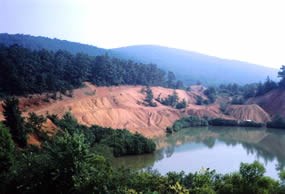
Human occupation of the The accumulation of these uses constitutes the history of the Park and the remnants (the walls, foundations, and other features) make up the cultural resources protected by the park. Each of these uses, while of value culturally, resulted in disturbances including either outright loss of natural resources or alteration of those resources. Under limited circumstances, restoration activities are undertaken to re-establish lost or damaged natural resources. Today most human activities that disturb the environment are forbidden within the park. Some activities are allowed to continue to facilitate park use and enjoyment. Construction and rehabilitation of buildings, roads, and utility corridors in the park are always carefully planned to minimize damage to park resources. New projects generally are limited to the existing disturbed "footprint". Before a project gets underway, the area is assessed for sensitive habitats or populations of rare plants or animals. Consideration is also given to impacts on soils, air, and water resources. In many cases after construction, the surrounding area is revegetated using plant material previously gathered from the area. The park has its own small nursery so that local seed and seedlings can be grown into plants to restore disturbed areas. Some disturbances are long lasting, and are difficult, if not impossible, to erase. Fortunately, ecologically, the Disturbance of park resources is not solely the result of human activities. Many natural events also cause disturbance. Ice storms and heavy snows bring down tree limbs and whole trees. Heavy rains cause flash flooding, debris flows in stream channels as well as mud slides. Water penetration and freezing cause rock falls. Insect and pathogen infestations cause declined condition and death of biological resources. Drought and wet conditions stimulate or inhibit plant growth and mast production, alter habitat availability and conditions for aquatic organisms, and influence population sizes of aquatic insects that are consumed by fish. Wildfires remove some types of plants but stimulate growth of others. Most of these natural agents of disturbance are briefly discussed elsewhere at this website (see Environmental Factors). The science of understanding land use, disturbance, and restoration is complex. It involves experts from many disciplines. Park staff members at Shenandoah have worked together on restoration projects at Big Meadows and on Hogcamp Branch. Related Information Useful references related to landscape use, disturbance, and restoration are: Egan, D. and E.A. Howell, ed. 2001. The Historical Ecology Handbook, A Restorationist’s Guide to Reference Ecosystems. Island Press, Sisk, T.D., editor. 1998. Perspectives on land-use history of Following is one helpful website: Society for Ecological Restoration
|
Last updated: February 26, 2015
